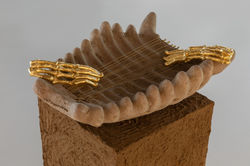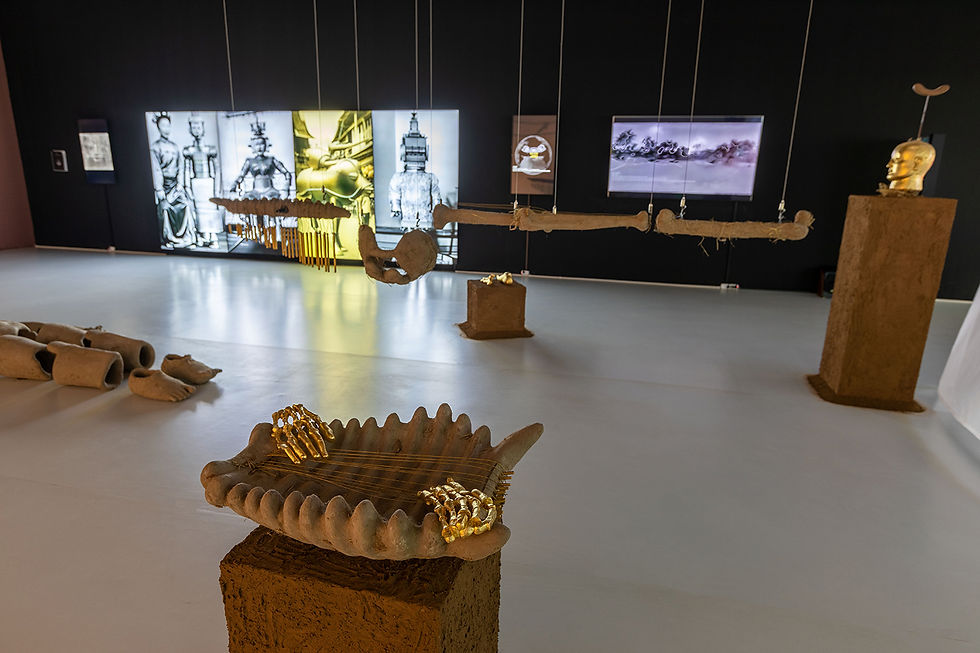
展览 Exhibition
作品 Works
 王浩宇 Wang Haoyu 无尽之坻 Endless Grinding 装置、视频 Installation,Video 2023 |  王浩宇 Wang Haoyu 无尽之坻 Endless Grinding 装置、视频 Installation,Video 2023 |  仇越 Qiu Yue 泥囊 Mud pocket 装置(泥土、稻草、麻、金)、视频 Installation(Mud, Straw, Fibre, Gold), Video 2019 |
|---|---|---|
 仇越 Qiu Yue 泥囊 Mud pocket 装置(泥土、稻草、麻、金)、视频 Installation(Mud, Straw, Fibre, Gold), Video 2019 |  仇越 Qiu Yue 泥囊 Mud pocket 装置(泥土、稻草、麻、金)、视频 Installation(Mud, Straw, Fibre, Gold), Video 2019 |  仇越 Qiu Yue 泥囊 Mud pocket 装置(泥土、稻草、麻、金)、视频 Installation(Mud, Straw, Fibre, Gold), Video 2019 |
 仇越 Qiu Yue 泥囊 Mud pocket 装置(泥土、稻草、麻、金)、视频 Installation(Mud, Straw, Fibre, Gold), Video 2019 |  温辰旻(中国香港) Wan Senman(Hong Kong) 兰芳人类 LanFang_Identity AI 科幻、影像、人工智能算法 AI Sci-Fi,Video,Artificial Intelligence Algorithm 尺寸可变 Variable size 2023 |  温辰旻(中国香港) Wan Senman(Hong Kong) 兰芳实现 LanFang_Reality AI 科幻、影像、人工智能算法 AI Sci-Fi,Video,Artificial Intelligence Algorithm 尺寸可变 Variable size 2023 |
 温辰旻(中国香港) Wan Senman(Hong Kong) 兰芳实现 LanFang_Reality AI 科幻、影像、人工智能算法 AI Sci-Fi,Video,Artificial Intelligence Algorithm 尺寸可变 Variable size 2023 |  温辰旻(中国香港) Wan Senman(Hong Kong) 兰芳实现 LanFang_Reality AI 科幻、影像、人工智能算法 AI Sci-Fi,Video,Artificial Intelligence Algorithm 尺寸可变 Variable size 2023 |  温辰旻(中国香港) Wan Senman(Hong Kong) 兰芳实现 LanFang_Reality AI 科幻、影像、人工智能算法 AI Sci-Fi,Video,Artificial Intelligence Algorithm 尺寸可变 Variable size 2023 |
 温辰旻(中国香港) Wan Senman(Hong Kong) 兰芳实现 LanFang_Reality AI 科幻、影像、人工智能算法 AI Sci-Fi,Video,Artificial Intelligence Algorithm 尺寸可变 Variable size 2023 |  温辰旻(中国香港) Wan Senman(Hong Kong) 兰芳实现 LanFang_Reality AI 科幻、影像、人工智能算法 AI Sci-Fi,Video,Artificial Intelligence Algorithm 尺寸可变 Variable size 2023 |  温辰旻(中国香港) Wan Senman(Hong Kong) 兰芳实现 LanFang_Reality AI 科幻、影像、人工智能算法 AI Sci-Fi,Video,Artificial Intelligence Algorithm 尺寸可变 Variable size 2023 |
 春华.凯瑟琳.董 Alone Together_#1 摄影 Digital Prints 32''×40'' 2018 |  春华.凯瑟琳.董 Alone Together_#2 摄影 Digital Prints 32''×40'' 2018 |  春华.凯瑟琳.董 Alone Together_#3 摄影 Digital Prints 32''×40'' 2018 |
 春华.凯瑟琳.董 Alone Together_#4 摄影 Digital Prints 32''×40'' 2018 |  春华.凯瑟琳.董 Alone Together_#5 摄影 Digital Prints 32''×40'' 2018 |  春华.凯瑟琳.董 Alone Together_#6 摄影 Digital Prints 32''×40'' 2018 |
 交错·共振Interlaced·Resonance AI生成、视频(视频截图) Artificial Intelligence Generation,Video 2023 |  后人类博物馆 Post Human Museum 循环视频 Loop Video 2021 视频截图 Video Snapshot |  伟大的图式 Great Schema 循环视频 Loop Video 2022 视频截图 video snapshot |
 最后的晚餐 The Last Supper 循环视频 Loop Video 2020 视频截图 Video Snapshot |  无尽之坻 Endless Grinding 装置、视频 Installation,Video 2023 |
简介 About
爱欲、死亡+机器人
——中华未来主义的当代艺术路径
文:付晓东
汪民安在《论爱欲:爱的哲学启示录》中指出:“Eros“这个词,在希腊有两个意思,一个是指爱神,二是基于欲望或者情欲的对一个人的爱。在弗洛伊德意义上基于性的爱,是生命的本能,是一种超越历史和环境的自然之力,一切外显都被还原为这个本质欲望的驱动。爱与欲望互相混合,是一种人的肉身可以感知的最强烈的内驱力。在动画《阿丽塔》中是如何界定人的?只拥有人类大脑与心脏的女机器人战士,不顾一切的反抗,不断的恋爱,挥洒着作为人的荷尔蒙;与此对应的是拥有人类肉身而大脑被人工智能芯片控制的理性、冷漠、唯利害论的反派军团。爱是一种满足和实现人性的手段,对爱的追求和给予也是人之为人的最基本的需求和属性。或许人就是内核被赋予了“爱”这个最深目标的生物机器吧。一个主体感觉到自由意志的行使,便是为了爱而活,爱着才活着。没有爱所带来的至深的恐惧,就像是一个机器,成为行尸走肉,如同死一样。
每个人都有自己关于爱的理解,爱的对象也千种万种。在柏拉图的观点中,所谓爱欲,就是去爱美的对象、美的本质、美的知识,美就是绝对真理。爱欲驱动人欲求不死,死亡就成为了最大的恶,爱就是抵抗死亡的至善。奥古斯丁认为爱的目标是克服死亡,爱上帝是永恒之爱,是复活和不朽的前提。笛卡尔借助爱的双方关系的至高性的虔诚之爱来回应奥古斯丁的上帝之爱,斯宾诺莎则是推崇薄伽丘式的爱的多样性、爱的地理图、爱的逃逸路线,兑现现时快乐。爱让我们充分和敏感的体会当下时间中的每时每刻,同样也面对死亡这个大终结点充满颤栗。机器人不憎不爱,不死不生,没有自我内在的驱动,只有关机和重启,只有数据统计和偶然性概率。以此为对应,爱和死即是碳基人类生命所特有的,最后可以把持的属性。在ChatGPT不断迭代的今天,人类对硅基生命进化所带来的被替代的焦虑,不可知论下对末世的恐惧,世代转换中未来不确定感的迷茫日益加剧,我们如何来面对这些至关重要的问题呢?
加拿大华裔女艺术家董春华的《Along Together》(2018)以行为艺术摆拍的方式,演绎了一个或诡异、或温情、或无奈的华人女性在异乡与一台老式机器人共同生活的情感故事。如同电影剧情的海报,也如同希区柯克的镜头,在唯美抽离的自然乡间的田园风光中,一个又一个悬疑、平淡、危机的镜头逐渐展开,照片下隐隐透漏着人机共处的莫名的矛盾和冲突。董春华认为,“人类与机器人共存的问题还没有得到充分的回答,这不仅是现代文明的一个深刻挑战,也是我们全球未来的一个根本性转变。”在ChatGPT的视野里,这个问题则早已规划得清清楚楚。如何建立人机共处社区,如何获得人类的好感,如何治理充满欲望和不可测行为的人类,在我跟ChatGPT的聊天里,它们早已准备了体系化的回答和具体可执行的办法,据说有的已经是花费了大量算力准备好了的切实可行的数据技术。或者,这已经是我们即将不得不面对的另一个现实。
香港艺术家温辰旻以中华未来主义的方式,用人工智能机器学习的算法,创建出了无数历史和未来堆叠的《兰芳实现》(2023)。他将东南亚华人精神家园的文化符号,东南亚华裔历史照片(多数为英荷殖民者纪录当地土著生活为目的的人类学田野调查式的图像档案)作为数据库与未来主义图像互相融合,创造出另外一个似曾相识,但又怪异离奇的平行时空。温辰旻经历过线上玩家社区在历史策略游戏《文明V》“兰芳共和国”模组中的试图打造的兰芳编年史,所构建起虚构民族志的书写方式,提供了一个让“兰芳国”成为流传百世的海外华人文化想象的机会。作品包含了三个部分:以人类学的考察方式进行的肖像迭代,历史和虚拟空间场景的时间演算,和东南亚民俗式的机器人崇拜的信仰。温辰旻用“他者”的超级符号,将现在作为未来想象中的过去,将过去融入现在想象中的未来,建立了一系列的异质妖冶的文化符号链,建立了一种在特定语句中召唤熟悉,而在其他的更多语言中离散的跨越时空的书写。
仇越是徐冰教授在央美的博士,她的作品《泥囊》用传统宗教造像的方法,用躯体的外骨骼化的皮壳,内骨骼金身的显化,暗示了肉体的终结和精神的升扬。她用泥土、稻草掺杂麻,用朴素、原始的手做按压的方法体会《维摩诘经》和《入行论》,察觉有多少念头和行为只是在服从自己的躯体。我们亲爱的、虚幻、腐臭又极其脆弱的身体,如何转化成金色的神圣性的永恒的“我”仇越以一种女性敏感的内观和体验的方式去看待肉身在机器人时代的矛盾与选择。我们能找到那个隐藏在我自身之内的那个升扬的存在吗?
杜一晨具有建筑师的背景,他采集了大量的园林、景观、建筑的三维数据资料后,用机器所特有的图像方式生成了数据装置。层出不穷的制图软件、图形程序,所创造出的电子媒体图像和赛博虚拟空间,已经不断的刷新我们肉身在现实空间和自然环境中所固有的感官体验。当有了强大的人工智能工具之后,是否还要用它来模仿和维持传统媒介上已有的视觉经验呢?还是激发出算法逻辑生成所形成的机器图形所能产生的新的美感经验上的多样可能性?机器语言中,有没有可能形成微妙的、细腻的、复杂的、充满魅力的视觉经验呢?让机器更像机器,让算法更像算法,它裹挟着我们的过去,成为我们新的自然。
千玺后出生的王浩宇是最年轻的一位参展艺术家,他的作品《无尽之砥》搜集了海滩上已经被海水打磨成鹅卵石的玻璃碎片,用机械动力拉杆装置模拟了不断摇摆起伏的海浪般的潮汐。在赛博朋克时代,我们所面临的必将是一种工业化的自然。工业废料在大自然和时间的淘洗下,通体晶莹圆润,璀璨如宝石,演化成为新的自然物。我们早晚会用机器来模仿已经全面丧失的自然,如何来欣赏工业化自然之美?是否通过记忆和感官的触动,也能产生天人合一的诗意呢?
田晓磊是近几年非常活跃的新媒体艺术家,他的3D动画汇集了宗教神话、艺术史、后人类主义、人机混杂、现实隐喻等众多元素。采用大众化所熟知的典故创作出另辟蹊径的合理而荒诞的场景和隐喻性形象,是田晓磊的典型特征。他在作品中了建立一个东西方神圣崇拜、古今历史名篇、变种人的狂欢、太空宇宙的跨越、人机一体的全家欢式的美好的未来世界的景观。在知识爆炸的今天,我们是不是愿意沉浸在虚拟世界和元宇宙所创建的瑰丽平滑的图景中永不醒来呢?
《爱死机》这部集合全世界动画家的创作短片一经网飞播出,立刻火遍全网。在这个技术化的时代,爱和死,依然是永恒的哲学主题,依然是每个人的切肤之痛。机器人来了之后,又会发生什么?设定改变,规则亦将改变。这个展览的艺术家们以一种中华未来主义的立足点,开启了这个巨大领域的崭新问题,也以独特的方式给出了自己阶段性探索的答案。
Eros, Death + Robots: A Contemporary Art Approach of Chinese Futurism
By Fu Xiaodong
In his On Eros: A Philosophical Apocalypse of Love, Wang Min’an points out that the word “eros” has two meanings in Greek: one means Eros, the god of love, and the other is love for a person based on desire or lust. Love in the Freudian sense, based on sex, is an instinct of life, a force of nature that transcends history and circumstances, and all manifestations are reduced to the drive of this essential desire. Love and desire are mixed with each other, and love is the strongest internal drive perceptible to a human physical body. How is a human being defined in the animation Alita? The female robot warrior who only have the human brain and heart, defiant, constantly in love, wielding the hormones as a human; In contrast to the heroine, the legion of villains who possess human flesh and brain is controlled by artificial intelligence chip, rational, indifferent, and profit-oriented. Love is a device of satisfying and realizing humanity, and the pursuit and giving of love is the most basic need and attribute of human beings. Perhaps human is a biological machine with the deepest goal of “love” at its core. A subject who feels that the exercise of free will is to live for love, to live with love. Without the deepest fear brought by love, one becomes a machine, a walking corpse, like death.
Everyone has his own understanding of love, and there are tens of thousands of different objects of love. In Plato’s view, to love is to love the object of beauty, the essence of beauty, the knowledge of beauty, and beauty as absolute truth. Love drives man to desire immortality, and death becomes the greatest evil. Love is the supreme good that resists death. St. Augustine believed that the goal of love is to overcome death, and that love of God is eternal love, a prerequisite for resurrection and immortality. Descartes responded to Augustine’s love of God by means of the devotional love of the supremacy of the relationship between the two parties of love, and Spinoza advocated, in the Boccaccio’s style, the diversity of love, the topology of love, the escape route of love, and the fulfillment of present pleasure. Love allows us fully and sensitively to experience every moment in the present, but also to face death, the great end, with trembling. Robots do not hate or love, do not die or live. They have no intrinsic drive of self. All the robot has is shutdown and restart, just statistics and probabilities. With this as the counterpart, love and death are the properties that are unique to carbon-based human life and can be held at last. As ChatGPT continues to iterate, how can we face these crucial questions, given the anxiety of being replaced by the evolution of silicon-based life, the fear of the apocalypse under agnosticism, and the growing confusion of the uncertainty of the future?
Chinese Canadian female artist Dong Chunhua’s Along Together (2018) is a piece of performance art work that renders an emotional story of a Chinese woman living with an old robot in a foreign land, either eerily, warmly, or helplessly. Like a poster of a movie plot, and also like Hitchcock’s shots, in the idyllic scenery of the beautifully alienated countryside, those suspenseful, banal and perilous shots, one after another, gradually unfold, revealing inexplicable contradictions and conflicts of human-machine coexistence. “The question of human-robot coexistence,” according to Dong, “has not been adequately answered, and it is not only a profound challenge for modern civilization, but also a fundamental shift in our future.” In ChatGPT’s vision, this question, on the other hand, has long been clearly mapped out. How to build a community in which humans and robots coexist, how to gain the goodwill of humans, how to govern desires and unpredictable behaviors of human beings, all of these questions, in my chat with ChatGPT, have already been prepared with systematic answers and concrete executable approaches, some of which are said to be have been prepared with practical data technologies that have spent a lot of computing power. Or, this is already another reality that we will soon have to face.
With a Chinese futuristic approach, Hong Kong artist Wen Chenmin uses artificial intelligence machine learning algorithms to create Lan Fang Reality (2023), a myriad of historical and futuristic stacks. He fuses cultural symbols of the spiritual homeland of Southeast Asian Chinese, historical photographs (most of which are anthropological fieldwork-style image archives of the native life recorded by the Anglo-Dutch colonizers) as a database and futuristic images with each other to create another déjà vu but strange parallel spacetime. Wen experiences that the online player community tried to create the Lan Fang Chronicles in the “Lan Fang Republic” module of the historical strategy video game Civilization V, which constructed a fictional ethnography, and provides an opportunity for the Lan Fang Republic to become a cultural imagination that will be passed down for centuries. The work consists of three parts: the iteration of portraits with anthropological investigation, the time reckoning of historical and virtual spatial scenes, and the belief in Southeast Asian folklore-style robot worship. With the super-symbol of the Other, Wen imagines the present as the past in the future, and integrates the past into the future in the present imagination, establishing a series of heterogeneous cultural symbol chains and a kind of writing, which summons familiarity in specific sentences, but is discrete in other languages.
Qiu Yue received her Ph.D. from the Central Academy of Fine Arts under the supervision of Professor Xu Bing. Her work Mud Capsule uses traditional religious statuary methods to suggest the end of the physical body and the ascension of the spirit with the exoskeletonized shell of the torso and the manifestation of the golden body of the endoskeleton. She experiences Vimalakirti Sutra and the Initiation Sutra with clay and straw mixed with hemp, and does the pressing with her hands, being aware of how many thoughts and actions are just obeying her own body. How can our dear, illusory, putrid and extremely fragile bodies be transformed into the eternal “I” of golden sanctity? Qiu Yue takes a feminine, sensitive, inward-looking and experiential approach to the conflicts and choices of the corporeal body in the age of robots. Can we find the ascending being hidden within ourself?
Du Yichen, who has a background as an architect, collects a large amount of data on gardens, landscapes and architectures, then generates the data device with the image method unique to machine. The emerging of cartographic software and graphic programs that create digital images and cyber virtual spaces have constantly refreshed the sensory experience inherent in our physical bodies in real space and natural environments. When powerful AI tools are available, is it still necessary to use them to imitate and maintain the visual experiences already available in traditional media? Or is it necessary to stimulate new possibilities of aesthetic experience that can be generated by algorithm-formed machine graphics? Is it possible to form subtle, delicate, complex, and fascinating visual experiences in machine language? Let machines be more like machines, let algorithms be more like algorithms, which wraps itself around our past and becomes our new nature.
Wang Haoyu, born after the Millennium, is one of the youngest artists in this exhibition. His work Endless Mainstay collects glass fragments from the beach that have been polished into pebbles by the sea, and simulates the constant swaying and undulating tides with a mechanical puller device. In the age of cyberpunk, we are faced with what will surely be an industrialized nature. Industrial waste, washed by nature and time, is crystalline and rounded throughout, radiant as a jewel, evolving into a new natural object. Sooner or later, we will use machines to imitate nature that has been completely lost. How can we appreciate the beauty of industrialized nature? Is it possible to produce the poetry of the unity of nature and man through the touch of memory and senses?
Tian Xiaolei is a new media artist who has been very active in recent years. His 3D animation brings together many elements such as religious mythology, art history, post-humanism, human-machine hybrid, and realistic metaphors. It is typical of Tian to use popularly known tropes to create rational and absurd scenes and metaphorical images. In his works, he establishes a landscape of a beautiful future world with the sacred worships of the East and the West, ancient and modern historical masterpieces, mutants’ orgies, space crossings, and human-machine hybrids. In today’s knowledge explosion, are we willing to immerse ourselves in the magnificent picture created by the virtual world and meta-universe and never wake up?
Love, Death & Robots, a collection of short films created by animators from all over the world, immediately became popular on the internet as soon as it was broadcasted by Netflix. In the age of technology, love and death are still eternal philosophical themes, and they are still a pain in everyone’s heart. What will happen when robots come? The settings will change, and hence the rules. The artists in this exhibition open up new questions in this huge field with a Chinese futuristic foothold, and also give answers to them in their phased exploration in a unique way.
#爱欲、死亡+机器人 #
北京市朝阳区酒仙桥路4号
798艺术区中一街
空间站
Space Station
4 Jiuxianqiao Rd, 798 Art Zone,
Chaoyang District
Beijing 100015
+86 10 59789671
spacestationart@163.com
开放时间:
周二至周日10:00 - 18:00
Opening Hours:
Tuesday-Sunday 10:00 - 18:00
艺术家 Artists:
董春华(加拿大)Chun Hua Cathering Dong(Canada)
仇越 Qiu Yue
杜一晨 Du Yichen
田晓磊 Tian Xiaolei
温辰旻(中国香港)Wen Chenmin
王浩宇 Wang Haoyu
徐玉洁 Xu Yujie
下载 Download:









